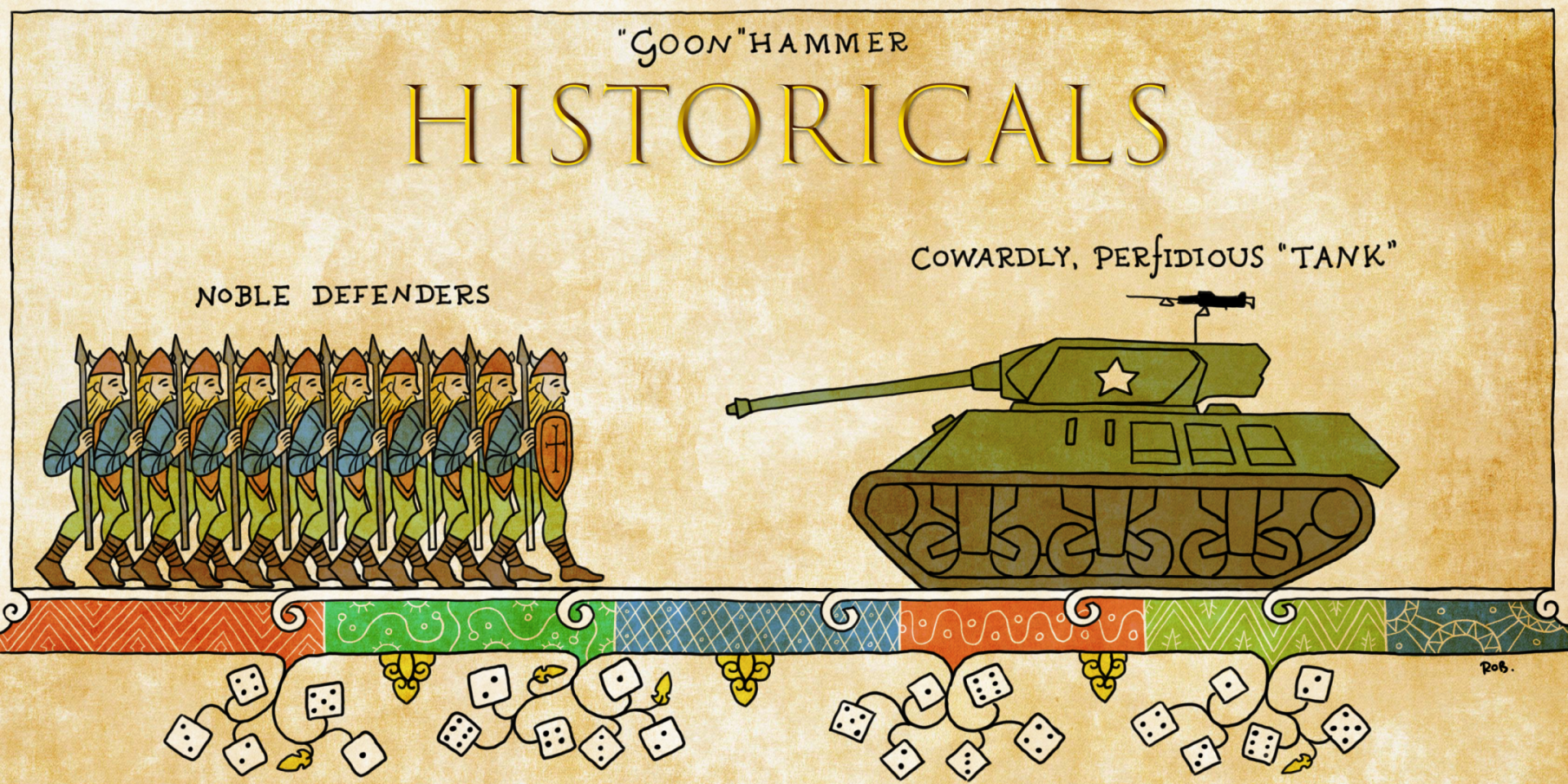It is still early spring in the foothills of the Spanish-Portuguese border. It is not hot, but it is humid. A light rain had fallen only two nights before, leaving the territory boggy and treacherous. Despite the temperate weather, the heavy woollen uniforms of the Légion Irlandaise bead perspiration on the faces of the troops assembled for the next charge. Only a few hundred yards away, the British await. The order goes out, a cry of “Abú Eire!” echoes through the forest, and the column advances. As the redcoats of the British line hone into view, the battle cries intensify. “Erin go bragh”, “Abú”, and even “Vive l’Empereur!” The cries are cut short by the first detonation. A fizzing rocket, released from just behind the British line, lands just to the left of the column. Several men fall wounded, the rest continue. “Dia Sabháil Éire!” The second explosion shudders through the right side of the line. Those knocked flat by the artillery fire gaze up at the cloudy sky, the sound of battle dimming as dirt and vegetation fragments rain down on their upturned faces. “Erin Go Bragh!” The lines form up, musket fire ripples back and forth, blue and red coats alike staining with blood, cries of pain cut sharply over the cries of battle. The lines finally meet, bayonet meets bayonet, sword meets sword, men die in anguish, and the colours flap proudly.
You might be mistaken for thinking that I’m describing a reenactment event in a particularly dramatic fashion, but for once my theatricality is serving a more pertinent point than simply gilding the lily. This was not reenactment, this was LARP – specifically, it was the final battle of The Forlorn Hope, told from the perspective of me, a crew member. While I do want to froth about how great the event was (and it was), I do also want to use this topic as a jumping off point for the challenges of historical depiction in interactive artforms like LARP, or indeed wargaming.
What Is The Forlorn Hope, and What Is LARP?
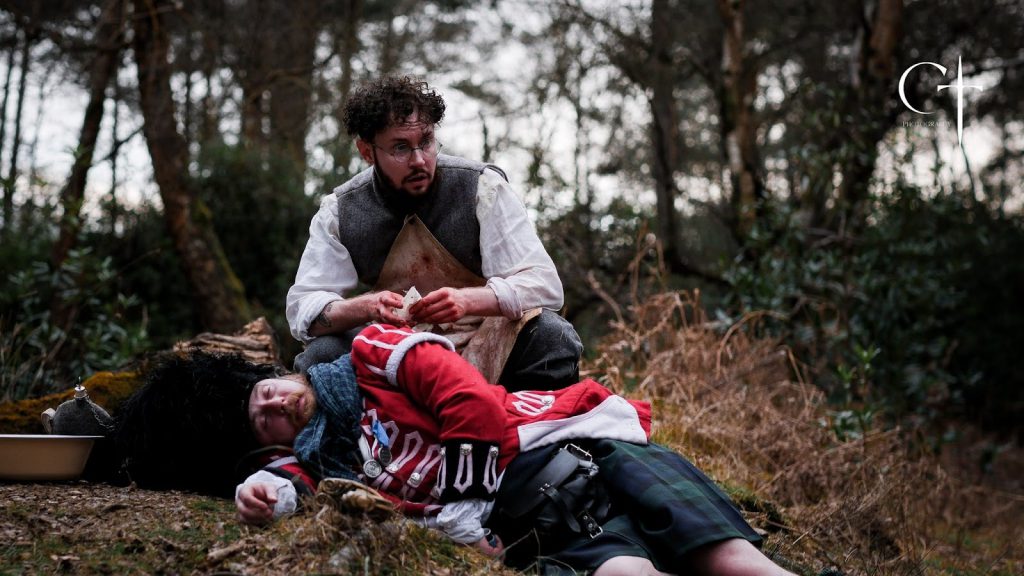
Most people reading are likely familiar with at least the basic conceit of LARP events. It’s like D&D, but instead of sitting round the table, you go to a physical space somewhere, pretend to be a character, and hit each other with fake weapons and shoot each other with fake guns. Some LARP events are very combat focused, some have no combat at all. Some are focused on the gradual accumulation of wealth and power, in others the only aim is to move fast and break stuff, preferably in a way that creates as much angst in the player base as possible. It’s roleplaying, theatre and combat reenactment, with varying ratios of each depending on the game. LARPs can be run as a regular weekly club event with a bunch of mates, or they can be run as colossal “festival LARPs” two to four times a year. They cover a range of different settings and genres, with the most common being traditional fantasy and science fiction.
In some ways, The Forlorn Hope is a typical LARP weekend event. A bunch of keen nerds get themselves into the country somewhere – in this case an airsoft site in Hampshire – camp out at night (to varying degrees of willingness and comfort), and spend the days pretending to be someone else, usually someone going through a bit of a Real One right now. What’s a bit more unusual is that The Forlorn Hope is a straight historical event, and one set in a very specific time and place. No orcs, no monsters, just a load of Brits, Spaniards and Frenchmen with muskets. The LARP is heavily inspired by Sharpe, and much like in the TV show, there are maybe 12 different people playing Frenchmen, and no more than about six of them appear on screen at any one time. Throw in Sean Bean somewhere and it’ll be like you’re on set.
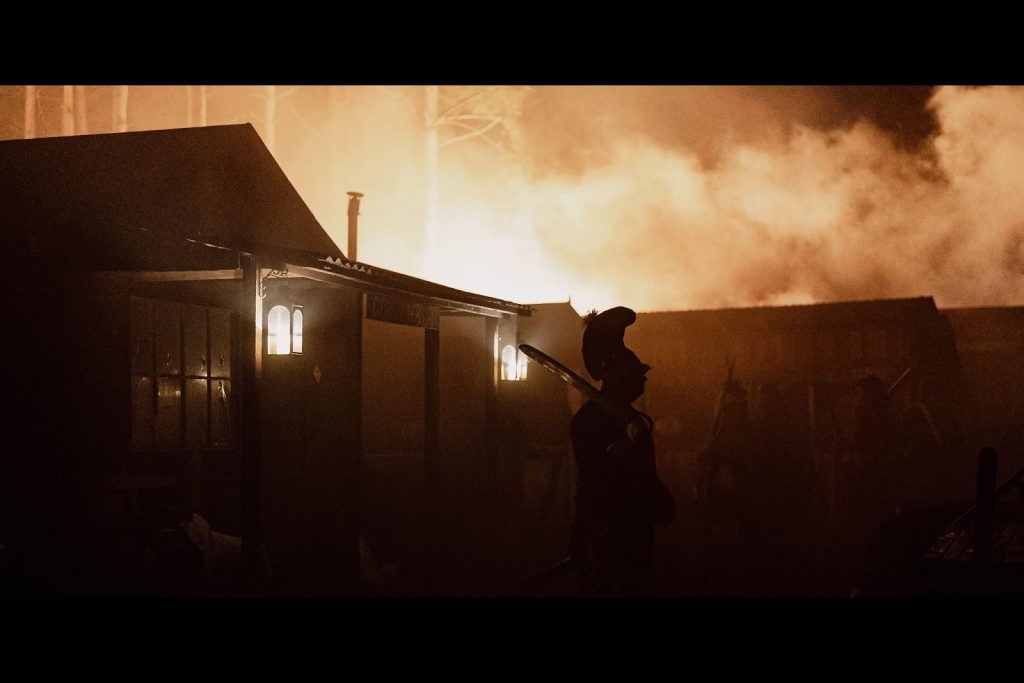
It is 1810, and the Peninsular War is in full swing. While the main body of the British forces were routed in the Battle of Talavera a mismatched band of troops, under the stewardship of the Earl of Chatham, remained behind French lines, attached to local Spanish guerilla forces. They work to undermine French efforts in the area and recover any important information, weapons and artifacts they might happen to discover. This is the player base. Not every player character is a soldier, some are British or Spanish civilians who happen to be accompanying the British forces, for whatever reason. But every character is expected to fit in with the broad standards and attitudes of the time. This creates an interesting problem, one that is more easily sidestepped in more fantastical LARPs.
Historical LARP and Diversity
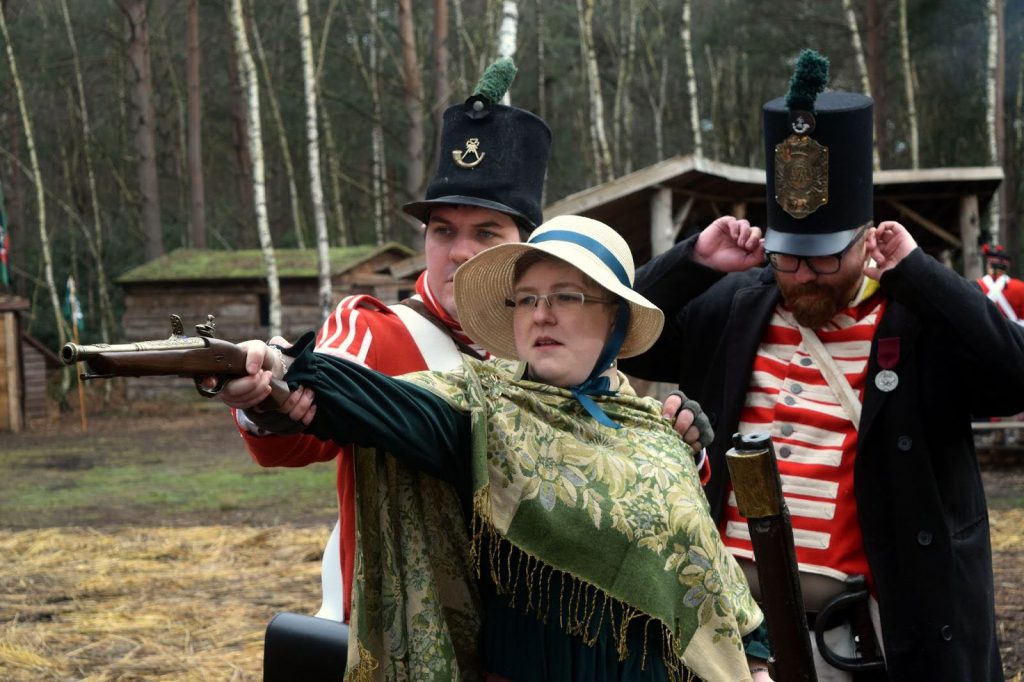
LARP is a diverse hobby, this is, of course, wonderful. If you think it isn’t wonderful, you’re probably on the wrong site. This diversity is not even remotely difficult to accommodate. If you’re creating a fictional setting for a LARP, you can build it from the ground up to incorporate people of all stripes and minimise the influence of real world inequalities. But The Forlorn Hope faces a greater challenge. It’s a historical LARP, and while it’s not slavishly devoted to historical accuracy, maintaining the verisimilitude of the period is a central part of the game’s appeal. So how does one represent not only a society which is riven with deep inequalities and prejudices, but also represent a specific subsection of that society (i.e. the military) which is explicitly exclusionary to *at least* 50% of the population. This is theoretically a problem in reenactment, but Historical LARPs face something of a different challenge set to reenactment.
I’m going to be quite general for a second, so keep that in mind before you leave a comment telling me that your local reenactment group does not conform to what I’m describing.
While reenactment tends to be more focused on the specific details of a setting – the clothes, the equipment, the tactical formations, the units – it’s usually less interested in that formless political miasma that permeates a given period. The power imbalances, the institutional incentives, the emotions that motivate and influence the behaviour of individuals.These might be present as part of play, but the intentionality of the event is to reenact existing historical narratives, not necessarily to create new ones within an established setting. This is actually theoretically a boon for reenactment when it comes to accommodating people. If you’re wearing the right uniform, the blanks are not hard to fill in, at least if you’re imaginative and not an arsehole. This is not to say that reenactment groups are always great at this, but very few actual changes to what is happening need to be effected to include people, as long as everyone’s prepared to accept regardless of their real life, they are probably a cis white dude in the context of this event.
However, in LARP, interpersonal connections, player-created characters, and organic narratives are central elements of the game. Players may not want to play female characters, queer characters, or non-white characters in a setting with explicit and extreme bigotry towards those people, especially if they themselves also share those identities. Going to the woods for a few days to be called racial slurs doesn’t sound like a whole lot of fun, sporty shako or no. Equally, it can be argued that entirely shaving off the sharp corners of a historical period has the potential to denude the setting of potential sources of drama. Frankly, LARPers love them some angst, and if you give them more things to be angsty about they will be happy campers (at least figuratively speaking, I happen to hate camping and do it only as a necessity for LARP events).
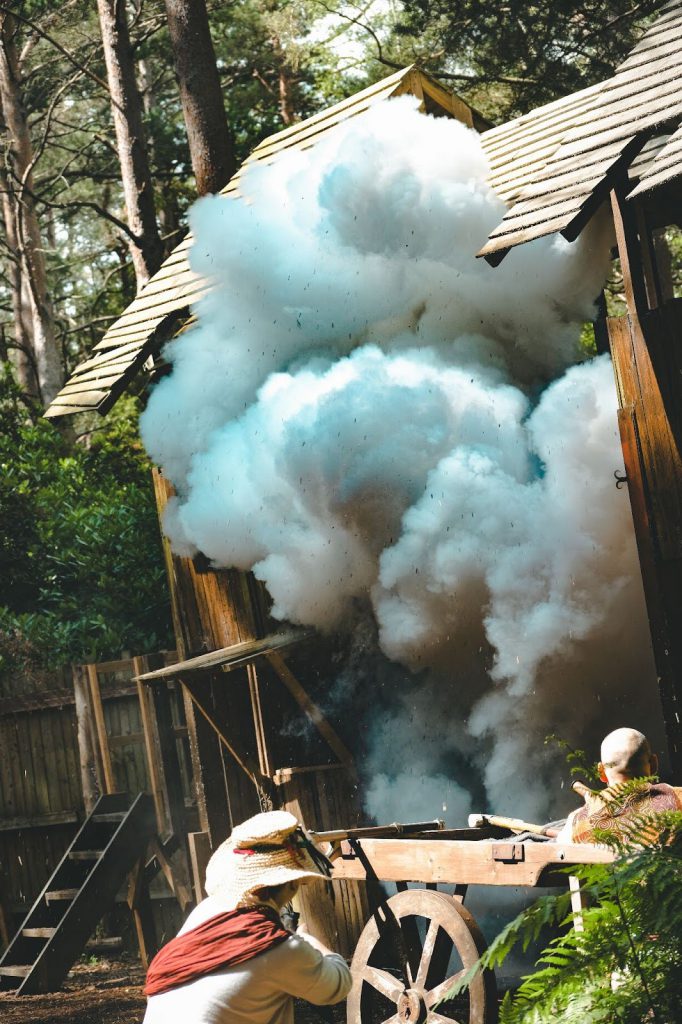
The Forlorn Hope threads this needle quite well. The real bigotries of the time are not entirely stowed, but softened. Wrapped in a layer of LARP-safe foam and latex, if you will. Male characters cannot oafishly lecture women, but may make an off-hand remark that is well-meaning yet patronising. Straight characters cannot harang a known gay character as a sinful grotesquerie, but they might make a tut-tutting remark about the importance of family and offspring. Basically, characters are not openly bigoted, but vaguely baffled and ill-informed about the unusual character traits of others. Race, wisely, is entirely sidestepped – it’s simply not a thing characters are going to comment on, one way or another. Soldiers must be at least masquerading as men and as straight, though their actual gender identity and sexuality is free for you to experiment with, in relative secrecy of course (sweet, sweet angst).
The Rules System
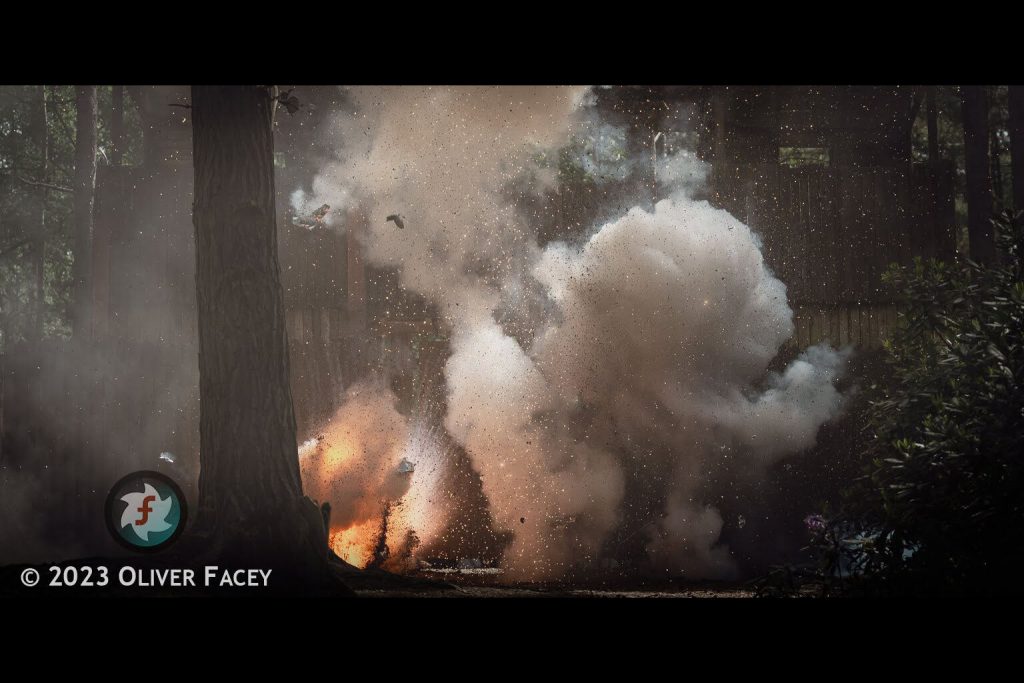
The complexity of LARP rules systems varies massively. Some have virtually none, and build storytelling through theatrical conventions rather than mechanised systems. Other are horrifically complicated, with multiple layers of maths, locational modifiers, and special rules (sometimes requiring a particularly convoluted practice known as “battleboarding”, in which the action is paused after every combat so select players can update their notebooks and tell players whether they’re dead or not). The Forlorn Hope is on the simpler end of the spectrum, and it emphasises cinematic storytelling over traditional gaming. In combat, you fight with considered, realistic blows (rather than fast, unrealistic blows designed to deal as many “hits” as possible, known in the hobby as “drum beating”), and you sell injuries at the moments you feel make the most sense, or at the most dramatically powerful time. Combat characters can be armed with a LARP-safe or reenactment musket (with party popper or percussion cap ammo, respectively) if they’re an infantryman, and additionally some sort of appropriate blade (and maybe a pistol) for officers, if they so wish. The target of your “shot” can be alerted by yelling some variation of “Oi Frenchie”, or a more specific call if you’re a rifleman (more accurate, you see). Whether the shot actually landed is basically up to the target!
On paper, this system seems ripe for abuse (what’s to stop someone just never selling a hit, ever), but in practice this doesn’t really happen. LARPers are here for the story, and they know that getting wounded is a good source of that aforementioned sweet angst. At a gigantic, several thousand strong mega-LARP like Empire, this might not work, but for a game with around under 100 dedicated players, it works just fine.
If you’re playing the military game, you enter the game without a commission, and it’s part of the game to try and earn yourself a promotion. This might be difficult or even impossible if your character is poor, as the class divisions of the time are very much a part of play. Characters can take a special perk that allows access to some portion of the game – they might be medically trained, maybe they can read French (which is out of character represented with blue text) or some other language, or have some combat perk, like being able to use a rifle.
The Event
The Forlorn Hope event I attended took place over the weekend of March 21st-23rd, with in-character time-in starting in the evening of the Friday, and time-out just past midday on the Sunday. I had decided to crew for this event rather than play, mostly because money is tight right now, and I didn’t fancy spending a bunch of cash on a musket and redcoat uniform. I only really knew one person attending, and I’d been a bit gun shy about LARP for a while due to a string of not great experiences, so on the evening of the Friday I milled about awkwardly while everyone warmly greeted their old friends. Thankfully, things picked up quickly. Unusually, during the safety and rules brief. The site at Eversley features a ton of custom built structures, including a wild west town (which fits in well with the Napoleonic theming), and a central camp, with several wooden huts (which can be used by players to sleep in) and a big canopied firepit area. It was dark by this point, but even seeing the murky outlines of the players in their full uniformed regalia in this cool environment was enough for my excitement to start to overcome my anxiety. After the briefing, those not playing headed back to the crew tent for their briefing.
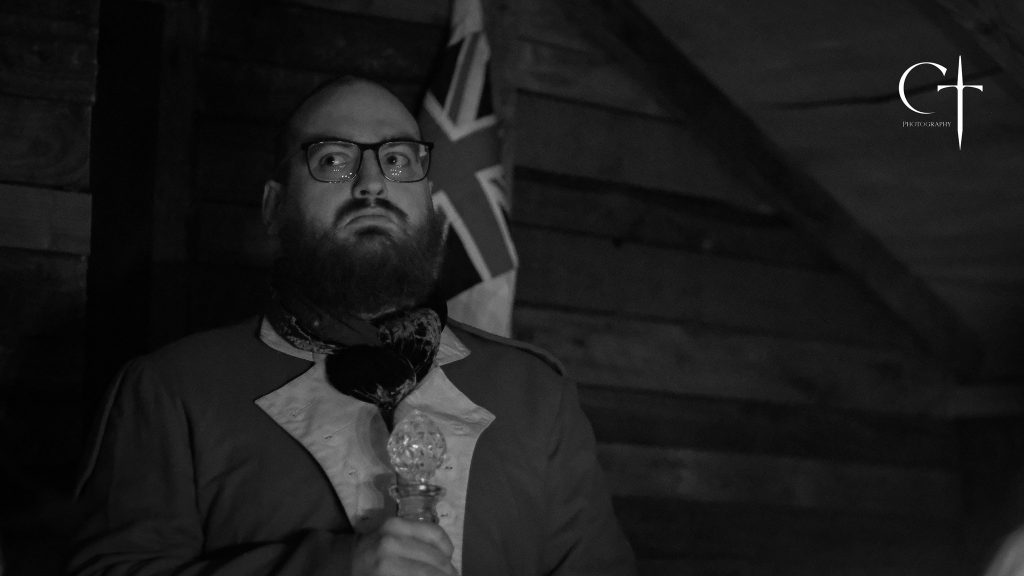
The central conceit of this event was that the Earl of Chatham’s band was withdrawing to safer parts, a training camp where they could resupply and recoup. At the same time, this camp was receiving a shipment of new recruits from Ireland, green as grass men with a boatload of internal religious tensions. That would be our task as crew for the first night, to arrive in camp and start violent disagreements with each other, and thus foster game. As well as the more generic Irish infantryman roles, the gamerunner, Harry, handed out some named characters. Apparently feeling unusually bold from my briefing excitement, I volunteered to play Robin Pattersly, the loyal batman to the Earl of Meath (the incompetent English noble leading the band of Irish troops). Robin was bereft over the death of the Earl’s former batman, Crispin Bale (now the penny has dropped, perhaps), who was a lifelong friend of his. I was to serve the Earl, and then retire to the enlisted men’s tavern, where I would wail and cry over my dead friend. After an evening serving port in the officers’ mess (at one point, a champagne bottle was opened with a sabre) and commiserating with the enlisted men, I turned in for the night.
On the second day, it turned out that my (for some reason) beloved master, the Earl of Meath, had come down with a mysterious illness. After helping him into camp, the player surgeons got to work bleeding him, and cutting open his various swellings and lesions. His former batman had died of the same mystery illness, a point I made repeated efforts to try and get them to internalise and act on, to no avail. After much deliberation, they concluded he had syphilis, despite numerous entreaties that the Earl “abhorred all carnal pleasures. The Earl did, in fact, have malaria, and their orders for him to get some bed rest and eat only thin broth was most likely going to kill him. There was a further complication. The Earl’s brilliant plan for the retaking of a local village had been much discussed the night before, but with the Earl indisposed, perhaps permanently, the players were forced to debate a new plan of action. Alas! With that bit of plot handed out, I headed back to the crew tent to prepare for the first fight of the weekend.
Donning a French infantryman’s coat, shako, and a LARP-safe musket, we headed into the woods of Eversly to meet the hated British in combat. The first battle was a minor skirmish against the British rifleman, in which the French got thoroughly trounced to the end of recovering a dead British infantryman’s body. Though the battle was excellent, I managed to out-of-character eat complete shit by tripping over a branch while storming through the brush. Thankfully my consequences were less severe than during a real Napoleonic skirmish, and I just banged up my leg. Between battles, I made a speech at the grave of my dear departed friend, before rushing off to get back into Frenchmen garb. The second skirmish was less of a loose skirmish, and involved some firing line drills. This time I once again injured myself a bit. While falling backwards after catching a musket ball in a firing line, I landed all my weight on first my right arm, then in a second fall, my left arm. Great! Only one out of four limbs was now in full working order. Being aware that Sunday would have an impressive final battle, I spent most of the Saturday evening chatting at the crew tent rather than fighting, to recoup my strength for the final push.
On Sunday morning, I headed back into camp as Robin Pattersly. Happily, the surgeons had finally realised the Earl did not, in fact, have syphilis. They had exhumed the body of the late Crispin Bale, realised their mistake, and applied the proper (for 1810) treatment to the Earl. He made a fast recovery. I managed to have an emotional reunion with the dear Earl as Pattersly, before he explained what his brilliant plan had been – run straight at the enemy. Good stuff. Unfortunately, the Irish unit had already moved out to execute the players’ less ostentatious plan, leaving the Earl’s genius unexploited. There wasn’t much more time for named NPC shenanigans, however, with a final battle to fight and only a few hours with which to do it. Back to the crew tent and into the imperial blue fatigues.
I’ve already done a dramatic retelling of the final battle, so now I’ll break kayfabe. There were maybe two dozen crew on the Légion Irlandaise side of the battle. The staging area was a long stretch of relatively wide path going through the forest, with trees on either side. In the ditches on either side of the path, the effects team had planted pyro pots, covered with silver foil and marked with flags. For the first wave of the attack, we advanced on the players straight down the path, in a 3-wide column. All hands were on deck for this battle, perhaps twice as many crew than in the weekend’s earlier skirmish. As a result, the column was somewhat more impressive looking.

Earlier in the weekend, the players had acquired rocket artillery, which they “fired” as we approached. After each rocket was “fired”, the pyro team detonated one of the pyro pots which the column was passing. The crew closest to the blast threw themselves down, dead or injured, until the column passed, at which point they stood up and rejoined the back of the column. Fairly soon into the battle I was kicking myself for leaving my ear plugs in my tent, as after a few blasts my ears were ringing. Once within a reasonable distance of the British line, we formed up in a line for musket volleys. For the first few waves, the crew referees made sure we didn’t get too aggressive – it’s important to give the players a sense that they’re holding their own. The players managed to capture the Irish colours (flag) at some point, which we tried in vain to retake in an effort to make the final charge just that little bit more dramatic. After a few waves of Irish broke upon the British line, the players were starting to hurt. Maybe half their number were writhing in agony just behind their line. Victory is always sweeter when it’s snatched from the jaws of defeat, so for the final wave the Irish were simultaneously aggressive yet brittle. After a single musket volley, bayonets were fixed and the lines clashed. After putting up enough of a fight to keep things satisfying, the last of the Irish rebels fell. Amidst the smoke and celebration, a lone redcoat ran towards the line. Good news, he proclaimed, the fresh Irish loyalists had somehow managed to take the village. The day was won! And time-out.
A Chat with Harry
The principal gamerunner of The Forlorn Hope is one Mr. Harry Knight, Esquire. Predictably he was horrendously busy for the whole weekend, so although I managed to exchange a few words with him (mostly about Silver Bayonet), it was hardly quote worthy material. I reached out after the event to run the article by him, and in the process managed to have both a good chat, and a game of Silver Bayonet (I lost, my Royal Navy squad getting ganked by Voltigeurs and Goblins).
HardyRoach: A lot of our readers will be familiar with reenactment, but this is something different. How would you explain the difference in approach for players and organisers?
Harry: Compared to reenactment, LARPs, even heavily historical ones like The Forlorn Hope, give you a lot more freedom. It’s similar to how a documentary and a show (such as Sharpe’s Rifles) or video game differ. The documentary is of course the best choice for pure history, but in being so precise it closes off potential avenues for diving into particular themes, or for giving agency to people who want to explore that period in a more fluid and natural way. In a similar way to historical wargaming, it’s possible to play the real battles of the period, but a lot of enjoyment and fun comes from seeing how different courses of action lead to different outcomes, or coming up with entirely new scenarios that, if things had been different, could have theoretically taken place within the historical period.
Generally at a reenactment event, particularly public facing ones, you play a role. For the Napoleonic period, this could be a soldier, a camp follower, or so on, but it’s often playing a particular archetype of society rather than a fully realised person. A historical LARP gives the opportunity to play an individual who exists fully within that period, with all the foibles and character traits that any individual has, without the distraction of appealing to an audience beyond your fellow players. Historical LARPs also give the opportunity to not be quite so laser focused on accuracy as Reenactment. A wrong belt buckle here, or a pair or modern hiking boots there for ankle support, are small things that can easily fade into the background at a LARP when you’re fully immersed in the period. This also allows a much lower buy-in cost than reenacting. While plenty of people at The Forlorn Hope do go all out on their costuming to make it as accurate as possible (and this looks fantastic!), having some extra wiggle room opens up the game to a much wider audience.
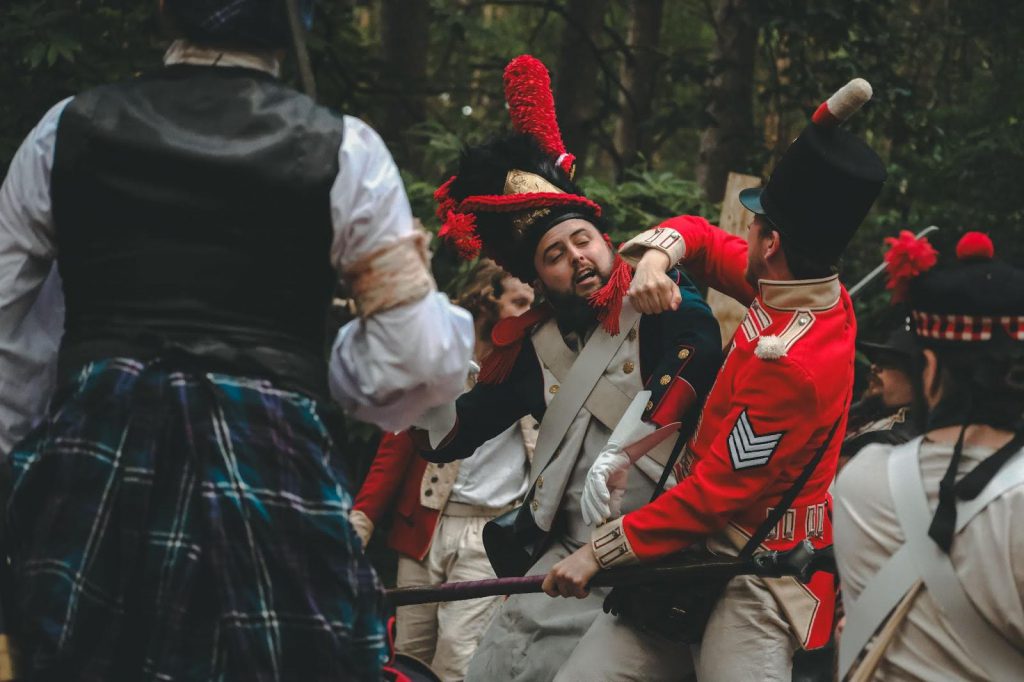
HardyRoach: How closely do you conform to history for this game? Is it just a jumping off point, or something more?
Harry: I come from a background in academic history, so I have a lot of respect for shaping the game around what would be going on during the period when the events are set. When writing a historical game, putting in the extra effort to tie it to the historical context you want it to be set in serves as a great tool to immerse your players in the setting. Being able to talk about what would have been the hot news of the day immediately gives characters interesting topics to disagree over and bounce off of. When I start writing a new event, I normally start by going to a timeline of the Peninsular war when deciding on when to set the game. This gives me a jumping off point to dig up some primary sources from the period, that then serve as inspiration for plot points and encounters that my players can interact with. At the last episode, which had a focus on Irish soldiers (fighting on both sides of the war!), for example, I took plenty of inspiration from “The Recollections of Rifleman Harris”, which contained several examples of Irish soldiers in Wellington’s army and the sorts of interactions they had with each other, and with other soldiers and civilians. While the events within the games are fictional, they are often based off of or take inspiration from real history, which can be more strange and interesting than even the finest fiction.
HardyRoach: There’s a lot of difficult considerations to keep in mind when running an inclusive game set in an exclusionary period. How do you thread that needle?
Harry: I’m incredibly fortunate to be supported by a diverse team of writers, from a broad variety of backgrounds. Together we spent many sleepless nights trying to find a way to handle the aspects of Regency society that are explicitly exclusionary. Significant amounts of Regency media, from literature to film, focus on how Britain was a deeply conservative society, with strongly enforced gender roles and expectations. Removing these aspects of history altogether would be disingenuous, and many players are drawn to the Regency period because they want to play with these tropes. We decided that while we wanted to preserve some of the strictly gendered flavour of the setting, we also didn’t want players to be shut out of areas of the game on the basis of gender. The themes and flavour that we want to preserve in the game make no sense when divorced from a deeply sexist social context, and it makes the most sense to assume that that context exists. However, we explicitly do not want setting flavour to take precedence over everyone having fun in a safe and open environment.
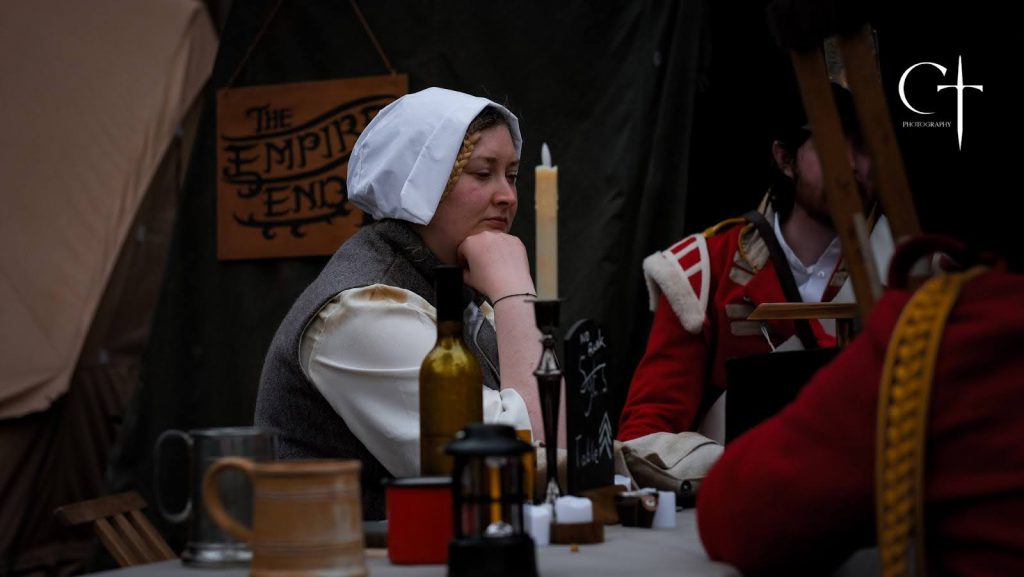
It was for this reason that we settled upon a two pronged approach to gendered roleplay. First, a character’s in-game gender is entirely determined by their clothes. This means that players who in real life identify as female or non-binary have as few barriers to playing British soldiers as possible, as they can simply dress in a masculine manner. In a similar fashion, the Spanish Guerilla player archetype is completely gender neutral: Comandante Teresa from Sharpe is a great example of a strong female combat character that would fit perfectly into The Forlorn Hope. Secondly, in our Peninsular war, we ask our players to not engage with the Regency idea of women as weaker, physically or mentally, than men. There is no way to square that circle with the historical attitudes of the day while still having the game be an inclusive and open environment. Instead, we shifted the period focus to be on Propriety, and the idea of playing to your station. This enables interesting interactions around the social norms of Christian morality and scandal, and encourages “Yes And” roleplay, where players can build each other up and explore the themes of the period in a safe manner.
Overall Impressions
There’s so many things that happened over the course of the weekend that I didn’t manage to catch – a regency ball was thrown, where era-appropriate dancing was conducted. A riot broke out at a Spanish village over women who had “comforted” the French troops before they pulled out, leading to one of the ladies having their heads shaven (being the greatest of sports, the crew member playing that character voluntarily had her hair cut to add to the experience, the rest was later buzzed off at the crew tent for symmetry’s sake). The fresh Irish loyalist troops were drilled through various exercises, including can-shooting (with pyro effects so the cans actually did burst and fall off the fence) and drills. Some players set-up a regency tea room with real cakes and beverages available.
For years now, LARP has been a bit of a difficult thing for me. For various real life reasons, I’ve had a tendency to get so overwhelmingly anxious in the lead-up to an event that I inevitably either bottle out of it, or go, have a miserable day and a half, then leave early.
But I’m happy to say the bad streak has been broken. I had an absolutely fabulous time. Crewing was an exceptionally good idea, so it’s just as well I couldn’t afford to play. Freed of the pressures of needing to perfect my own character and “find game”, I was able to rediscover the joys of getting to know new people, interacting with characters, and the magic of well-done LARP combat. I don’t think I’ll ever forget charging forward through the smoke at a musket line as real pyro pots explode, or lying face-up, dead from an explosion that blasted off right next to me, with debris raining down.
Forlorn Hope provides an equally fun and engaging creative experience for both the players and the crew. It managed this while creating a historical experience that managed to feel authentic, while not being exclusionary. These are both incredibly difficult needles to thread in the world of LARP design,
So thanks to everyone involved in Forlorn Hope, the crew, the organisers, the players, for helping me feel excited about LARP again, and maybe giving me the drive I need to actually have a good time again at other LARPs. If readers out there have ever been tempted to give LARP a go, I can’t recommend this experience highly enough. If you fancy it, I’ll see you at event two. I’m the white guy with a beard and a bit of a gut, I’m sure that’ll narrow it down nicely.
Have any questions or feedback? Drop us a note in the comments below or email us at contact@goonhammer.com. Want articles like this linked in your inbox every Monday morning? Sign up for our newsletter. And don’t forget that you can support us on Patreon for backer rewards like early video content, Administratum access, an ad-free experience on our website and more.
